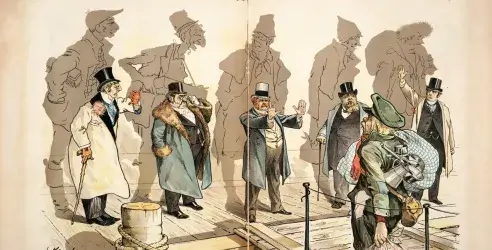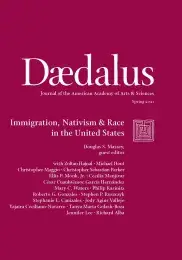
The Bipartisan Origins of White Nationalism
Dysfunctional immigration and border policies implemented in recent decades have accelerated growth of the Latino population and racialized its members around the trope of illegality. Since the 1960s, Republicans have cultivated White fears and resentments toward African Americans, and over time these efforts broadened to target Hispanics as well. Until 2016, this cultivation relied on a dog whistle politics of racially coded symbolic language, but with the election of Donald Trump as president, White nationalist sentiments became explicit and White nationalism emerged as an ideological pillar of the Republican Party. This volume confirms this political transformation, describing its features and documenting its consequences. In this essay, I describe the unwise U.S. immigration and border policies that were steadily promulgated and expanded over the decades by Democrats as well as Republicans, inevitably leading to the current racist and nativist moment. I close by offering a way forward by granting legal status to those who currently lack it, while simultaneously dismantling the nation’s formidable machinery of immigration and border enforcement.
Immigration & the Origins of White Backlash
The success of Donald Trump’s anti-immigrant campaign surprised many. But I show that it was actually a continuation of a long-standing Republican strategy that has targeted immigrants and minorities for over five decades. It is not only a long-term strategy but also a widely successful one. Analysis of the vote over time shows clearly that White Americans with anti-immigrant views have been shifting steadily toward the Republican Party for decades. The end result is a nation divided by race and outcomes that often favor Whites over immigrants and minorities.
Immigration, Race & Political Polarization
Americans’ views of immigration are substantially more positive than political discourse since 2010 might suggest. And they are becoming more positive. So too are Whites’ views of Blacks, as racial resentment declined from 2010 to 2018. Views of immigration and race became more correlated over the last twenty years. And both are more correlated with political party preference now than at any time on record. While Republicans’ views of immigration and their racial resentment have changed very little since 2010, Democrats’ views of immigration have become far more positive and their racial resentment has declined substantially. The consequences of these trends were borne out dramatically in the 2016 presidential election. In combination, the two attitudes predict well who voted for Trump and who voted for Clinton. These trends and correlations make clear that xenophobic Americans are not ascendant, they are desperate. The dynamics of race, immigration, and polarization tilt in favor of both more immigration and a more progressive view of racial disparities.
Status Threat: Moving the Right Further to the Right?
Over the last few years, right-wing movements have proliferated among Western democracies. Although much of the growth has taken place across the “pond” in Europe, this phenomenon is not confined to that continent. As recent events make clear, the United States is another major case. In this essay, I offer a theory of the emergence of reactionary movements, fueled by status threat, using the United States as a case. To demonstrate the explanatory range of the theory (and measure), I focus on immigration, impeachment, and support for Donald Trump in the 2020 election. Examining self-identified Republicans only, I argue that status threat motivates the reactionary wing of the GOP in the United States. Drawing on data culled from a national sample, I find support for my expectation that, beyond ideology and racism, status threat furnishes a new explanation for reactionary preferences. I close with a discussion of the implications.
The Unceasing Significance of Colorism: Skin Tone Stratification in the United States
For many decades now, social scientists have documented immense ethnoracial inequalities in the United States. Much of this work is rooted in comparing the life chances, trajectories, and outcomes of African Americans to White Americans. From health to wealth and nearly every measure of well-being, success, and thriving one can find, White Americans remain ahead of Black Americans. What this focus on ethnoracial inequality between “groups” obscures, however, is long-standing skin tone inequality within groups. In this essay, I trace the trajectory of colorism and skin tone stratification in the United States over the past century. Next, I highlight the contemporary persistence of skin tone stratification, not only among African Americans, but among Latinx and Asian Americans as well. I conclude by arguing that future research on colorism will be essential to understand comprehensively the significance of race/ethnicity in a demographically shifting United States (such as immigration and “multiraciality”).
The Racialization of “Illegality”
This essay examines the intertwined nature of seemingly neutral immigration laws that illegalize certain immigrant groups and the socially constructed attitudes and stereotypes that associate the same legally targeted groups with “illegality,” to produce the racialization of illegality. These complementary factors are further sustained by other social forces, including media discourses that reify those associations. The racialization of illegality is a fundamentally situational, relational, dynamic, and historically and context-specific process. Today, Latino groups are the preeminent target group of both the social and the legal production of illegality. Thus, this essay examines Latinos’ racialized illegality across geographical contexts, within their group, and in relation to other contemporary immigrants. Although expressions of racialized illegality and specific targeted groups will vary across time and space, the contours of the phenomenon will be present across contexts and times (and produce specific outcomes) because they are shaped by existing racial hierarchies.
Criminalizing Migration
Beginning in the 1980s, the United States embarked on a decades-long restructuring of federal laws criminalizing migration and increasing the consequences for migrants engaging in criminal activity. Today, the results are clear: a law enforcement apparatus and immigration prison system propelled by a vast infrastructure of laws and policies. The presidency of Donald Trump augmented this trend and brought it to public attention. But lost in President Trump’s unique flair is an ideological commitment shared by multiple presidential administrations and legislators from both major political parties to use the criminal justice system and imprisonment to sift migrants. Examining these ideological attachments reveals Trump-era policies to be the outer edge of decades-long trends rather than extreme and momentary deviations from the norm.
Race, Legal Status & Social Mobility
In this essay, we review what is known about the role of race and legal status in the incorporation of immigrants in twenty-first-century America. While race and ethnicity matter in the social mobility of immigrants, racialization is not the impassable stumbling block critical race theory predicts. The research paints a remarkably consistent picture of intergenerational socioeconomic progress, one that is very similar to what happened with immigrants from Europe a century ago. This mobility is accelerated for Asians and Blacks, but slower among Latinxs. Legal status is increasingly a block to integration and affects both undocumented immigrants and their citizen children. While race and legal status intersect, we conclude that legal status is now playing a relatively autonomous role in limiting the life chances of many immigrants. We raise the alarm about not only the direct effects of legal status, but its increasing role in racializing and excluding Latinx Americans.
The Legal Status Divide among the Children of Immigrants
Over the past thirty-five years, federal immigration policy has brightened the boundaries of the category of undocumented status. For undocumented young people who move into adulthood, the predominance of immigration status to their everyday experiences and social position has been amplified. This process of trying to continue schooling, find work, and participate in public life has become synonymous with a process of learning to be “illegal.” This essay argues that despite known variations in undocumented youths by race, place, and educational history, undocumented status has become what Everett Hughes called a “master status.” The uniform set of immigration status–based exclusions overwhelms the impact of other statuses to create a socially significant divide. The rise, fall, and survival of the Deferred Action for Childhood Arrivals program, a policy offering qualified youths a temporary semilegal status, have underlined how closely access and rights hew to the contours of contemporary immigration policy.
Latinos & Racism in the Trump Era
This essay examines the roots, causes, and effects of racism experienced by Latinos in the Trump era. We argue that Trump and his administration were not the origin of Latinos’ experiences of racism, but his rise to power was, in part, derived from Latino racialization. Preexisting politics of Latino immigration, Whites’ fear of loss of status due to demographic shifts, and historical and contemporary processes of racializing Latinos were seized by the Trump administration and made central features of his renegade presidential campaign and policy agenda. White nationalist racism became the defining feature of the Trump presidency, making Latinos’ heightened experiences of racism, and the relegitimization of overt White nationalism, one of its lasting legacies.
“Trauma Makes You Grow Up Quicker”: The Financial & Emotional Burdens of Deportation & Incarceration
Research on the impacts of incarceration and deportation describes the negative consequences for children and young people. But how these events impact adults and members of extended families has not been broadly considered. And no study has directly compared incarceration with deportation. The study described in this essay, based on interviews with 111 adult individuals with a family member deported (57) or incarcerated (54), reveals how these experiences have long-lasting emotional and financial impacts and considers the similarities and differences between incarceration and deportation. The deportation or incarceration of parents is devastating; yet the absence of other relatives such as sons, sisters, brothers, aunts, cousins, grandchildren, and other household members also translates into severe sentimental and economic hardships not only for the immediate but also for the extended family.
Asian Americans, Affirmative Action & the Rise in Anti-Asian Hate
No court case in recent history has propelled Asian Americans into the political sphere like Students for Fair Admissions v. Harvard, and no issue has galvanized them like affirmative action. Asian Americans have taken center stage in the latest battle over affirmative action, yet their voices have been muted in favor of narratives that paint them as victims of affirmative action who ardently oppose the policy. Bridging theory and research on immigration, stereotypes, and boundaries, I provide a holistic portrait of SFFA v. Harvard and focus on Asian Americans’ role in it. Immigration has remade Asian Americans from “unassimilable to exceptional,” and wedged them between underrepresented minorities who stand to gain most from the policy and the advantaged majority who stands to lose most because of it. Presumed competent and morally deserving, Asian Americans subscribe to the stereotype, and wield it to their advantage. Competence, moral worth, and respectability politics, however, are no safeguards against racism and xenophobia. As fears of the coronavirus arrested the United States, so too has the rise in anti-Asian hate.
The Surge of Young Americans from Minority-White Mixed Families & Its Significance for the Future
The number of youth from mixed majority-minority families, in which one parent is White and the other minority, is surging in the early twenty-first century. This development is challenging both our statistical schemes for measuring ethnicity and race as well as our thinking about their demographic evolution in the near future. This essay summarizes briefly what we know about mixed minority-White Americans and includes data about their growing numbers as well as key social characteristics of children and adults from mixed backgrounds. The essay concludes that this phenomenon highlights weaknesses in our demographic data system as well as in the majority-minority narrative about how American society is changing.
